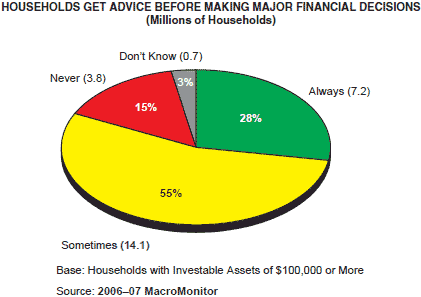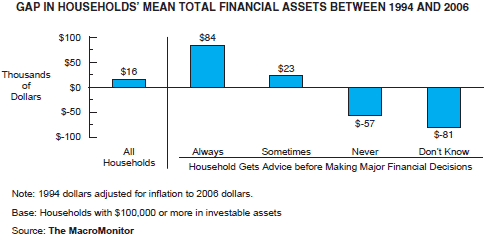The Financial-Advisor Advantage MacroMonitor Marketing Report Vol. IX, No. 2 May 2009
The past 30 years have exposed U.S. investors to bull markets, corrections, recessions, a productivity revolution, Y2K, the Internet, the dot-com crash, terrorism, globalization, corporate malfeasance, emerging markets, commodity shortages, declining health-insurance coverage, day trading, $4-plus-per-gallon gas, bear markets, extreme volatility, house flipping, a real estate boom and bust, overextended credit cards, subprime mortgages, ARMs, increasing use of ATM and debit cards, and on and on. These trends and events, in combination with an ever-increasing complexity in the investing environment, have created great uncertainty for investors. Increased awareness, sophistication, and technical capabilities have enabled many investors to shift from being totally reliant on financial advisors to being much more self-reliant and beholden to no financial professional. The critical questions for today's investor: Does my using a financial professional provide an advantage? Will regularly obtaining advice improve my household's bottom line?

SRI Consulting Business Intelligence's (now Strategic Business Insights') CFD group conducted an analysis of Investor households (for this analysis, households with at least $100,000 in investable assets) to determine the effect of their receiving financial advice over a 12-year period from 1994 to 2006. We found that Investor households in 2006 that always obtain advice before making a major financial decision averaged $84,000 more in financial assets than did Investor households in 1994 that always obtain advice. Investor households that only sometimes obtain advice had an average $23,000 more in financial assets in 2006 than their cohorts had in 1994. Investor households in 2006 that never obtain advice and those that don't know if they do actually had considerably less in average financial assets than did their cohorts in 1994 (–$57,000 and –$81,000, respectively).

On the basis of our data, analysis, and our 30-plus years of expertise, we found that households with at least $100,000 in investable assets that regularly receive advice have done better financially than those that sometimes or never receive advice. However, the reasons for this better performance may not be what one might expect. This analysis looks at the Investor's total situation, including demographics, financial metrics, complete product portfolio, use of financial advisors and other sources of information and advice, and financial attitudes to determine why they may do better. And although today may be too early for us to see the impact of the current economic and market volatility, we can assume that the Investors who maintain a balance in all aspects of their financial situation with the help of a knowledgeable, experienced professional financial advisor, will not only sleep better at night but will do better financially in the long term than their less-frequently advised cohorts.